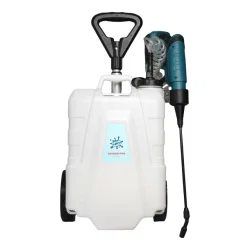Types of garden sprayers
2023-11-13
A garden sprayer is a tool used for applying liquid solutions, fertilizers, pesticides, herbicides, and water to plants in a controlled and efficient manner. These sprayers are commonly used in gardening, agriculture, and landscaping to ensure proper care and maintenance of plants. Garden sprayers come in various types, sizes, and designs to cater to different needs. Here are some common types of garden sprayers:
1. Handheld Pump Sprayer:
- Design: These sprayers have a pump mechanism operated by hand. Users pressurize the tank by pumping a handle, and then spray the liquid by pressing a trigger or lever.
- Capacity: Typically come in smaller sizes, suitable for small gardens or targeted applications.
- Applications: Ideal for spot-treating weeds, applying insecticides, or spraying fertilizers on individual plants.
2. Backpack Sprayer:
- Design: Similar to handheld pump sprayers but worn as a backpack for ease of carrying. They have a larger capacity and are equipped with shoulder straps and a wand for convenient application.
- Capacity: Larger than handheld sprayers, making them suitable for medium-sized gardens or lawns.
- Applications: Useful for treating larger areas, such as lawns or ornamental beds, with pesticides, herbicides, or fertilizers.
3. Knapsack Sprayer:
- Design: Similar to backpack sprayers but often have a more traditional design with a vertical tank.
- Capacity: Can vary, but they are generally larger and suitable for medium to large gardens or agricultural applications.
- Applications: Used for spraying pesticides, herbicides, and fertilizers on crops and larger garden areas.
4. Hose-End Sprayer:
- Design: Attaches directly to a garden hose and mixes liquid concentrate with water as it sprays. Some models have adjustable settings for different dilution ratios.
- Capacity: Relies on a continuous water supply from the hose.
- Applications: Convenient for applying liquid fertilizers, insecticides, or herbicides to larger areas without the need for manual pumping.
5. Trigger Sprayer:
- Design: Similar to handheld pump sprayers but with a trigger mechanism for spraying instead of manual pumping.
- Capacity: Typically smaller and suitable for smaller gardens or for spot treatments.
- Applications: Useful for targeted applications, such as applying insecticides to individual plants.
6. Compression Sprayer:
- Design: Features a compression pump that pressurizes the tank, similar to handheld pump sprayers. They often come with a wand and nozzle for precision.
- Capacity: Can vary, suitable for a range of garden sizes.
- Applications: Versatile for applying various liquids, including fertilizers, pesticides, and herbicides.
7. Electric or Battery-Powered Sprayer:
- Design: Powered by electricity or batteries, eliminating the need for manual pumping. They may have adjustable settings for different spray patterns.
- Capacity: Varies, suitable for different garden sizes.
- Applications: Convenient for users who prefer not to pump manually, and often used for applying various liquid solutions.
When selecting a garden sprayer, consider the size of your garden, the type of applications you plan to perform, and your preference for manual or powered operation. It's important to follow proper maintenance and cleaning procedures to ensure the longevity and effectiveness of the sprayer.



